by Coffee Kevin | May 4, 2017 |
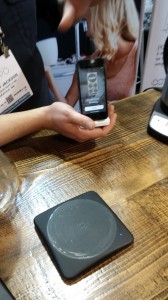 One of the reasons I so enjoy the Specialty Coffee Association’s Expo is running into products that are in the pipeline, but not quite ready. I realize how this happens. The inventors are tweaking them up until showtime and then the lights come up. Do we or do we not exhibit it? I mean it’s not quite ready? As we used to say in my previous life in television, “We never finish anything. We just abandon it.”
One of the reasons I so enjoy the Specialty Coffee Association’s Expo is running into products that are in the pipeline, but not quite ready. I realize how this happens. The inventors are tweaking them up until showtime and then the lights come up. Do we or do we not exhibit it? I mean it’s not quite ready? As we used to say in my previous life in television, “We never finish anything. We just abandon it.”
Well, I’m exaggerating a bit with that last line. In this case, Espresso Supply has an app which will definitely be finished. Meaning it will be released and no doubt work for its purpose. Its purpose? It’s designed to assist you when making coffee in a manual brewer. I noticed that they brought along a Chemex, which of course made me happy as it’s one I often use at home. It was quite inclusive of them, considering they have a number of their own manual brewing designs. Glad to see they’re above corporate jingoism that might have cause them to insist it be one of theirs.
The idea is to weigh your coffee on this scale. The scale sends this information to your phone and the app then tells you how much water to pour, step by step. It’s really quite simple to use. The goal is to make manual brewing as consistent as possible. It also allows you to change your grounds weight; then the app will automatically change how much water it tells you to pour into the brewer. This is one of those products where descriptive words take more time and effort than just using it. Espresso Supply’s Elliot Jackson demonstrated this in-development app for me, I recorded his demo along with his observations about its potential.
 It’s worth noting it’s my opinion that the use of such a tool will become more and more useful as it covers more variables. If course as it stands today, it will help maintain brewing consistency. But the real power will come when it monitors the grind. Those of us who attempt to vary batch sizes in a drip brewer know that slight grind adjustments can enable practically identical flavor profiles when changing batch sizes, and this is really difficult. While the demo didn’t demonstrate the app’s capability to change batch size parameters, and it’s unlikely that v1 addresses grind at all. Long term this is the dream I have for all of these products.
It’s worth noting it’s my opinion that the use of such a tool will become more and more useful as it covers more variables. If course as it stands today, it will help maintain brewing consistency. But the real power will come when it monitors the grind. Those of us who attempt to vary batch sizes in a drip brewer know that slight grind adjustments can enable practically identical flavor profiles when changing batch sizes, and this is really difficult. While the demo didn’t demonstrate the app’s capability to change batch size parameters, and it’s unlikely that v1 addresses grind at all. Long term this is the dream I have for all of these products.
Congratulations, Espresso Supply for taking some first steps to move toward this along. Here’s hoping it’s released in in field use soon!
Podcast: Play in new window | Download
Subscribe: Android | Email |
by Coffee Kevin | Sep 6, 2016 |
 I have always been intrigued by Café Grumpy. Never have I heard so many scary rumors of the tough love treatment of consumer electronics, coupled with praise for their beverages. Such media luminaries as Bruce Cost (creator of my favorite ginger ale) to HBO Girl’s Lina Dunham, where her character works as an uninspired barista on the show. I was so disheartened when Oren’s Daily Roast left Grand Central Station to reopen as a Starbucks. My enthusiasm returned when Starbucks left and Café Grumpy inherited the Grand Central location.
I have always been intrigued by Café Grumpy. Never have I heard so many scary rumors of the tough love treatment of consumer electronics, coupled with praise for their beverages. Such media luminaries as Bruce Cost (creator of my favorite ginger ale) to HBO Girl’s Lina Dunham, where her character works as an uninspired barista on the show. I was so disheartened when Oren’s Daily Roast left Grand Central Station to reopen as a Starbucks. My enthusiasm returned when Starbucks left and Café Grumpy inherited the Grand Central location.
Caroline Bell was on my Future of Coffee Panel at the New York CoffeeCon in 2015. I found her quiet but thoughtful and someone who waited patiently for her turn at the microphone but always added substance and reason to the discussion. So it was that I had to pester her to join me on this podcast, even though I know she’d obviously prefer painful dental procedures to being interviewed.
While visiting Grumpy’s roastery, I was impressed with the fact that they’d roasted so long with a tiny L12 Probat roaster, which sat unused next to a more recent and much larger Probat model. I want to point out the Grumpy’s is one of those roasters where the team concept is in full view. Liam Singer is the talented roastmaster and Cheryl Kingan their painstakingly careful green buyer. While much of the coffee world has taken to presenting a giant assortment of single-origins, Grumpy’s has the courage to keep the menu short and simple and savory.
Caroline told me her grandparents worked in radio. She has a beautiful voice, no doubt in part being a descendant of trained radio talent. Perhaps the most surprising part of our interview as when I asked her favorite brewing method and she said French press. Made me want to try her coffee in a press, which I did the moment I arrived home. My suspicion is that many roasters choose green and roast their coffees with a favorite brewer in mind.
Enjoy.
Podcast: Play in new window | Download
Subscribe: Android | Email |
by Coffee Kevin | Jun 16, 2016 |
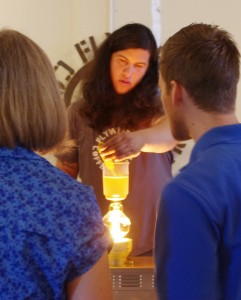 The Hario Syphon is perhaps the ultimate quality siphon, also long-known as a vacuum coffee maker. The Syphon works on the principal that near-boiling hot water in an enclosed lower vessel releases steam that expands, forces the hot water up through a tube into the upper bowl, where it is inherently the right temperature to brew coffee. As long as the lower bowl is kept heated, the water will stay up there, brewing coffee. The bubbling below causes the water in the upper bowl’s water to agitate the grounds, facilitating the extraction process. When the operator decides enough is enough, she simply removes all heat below and within about a minute the cooling and contracting vapors below cause the lower bowl to suck (hence the word vacuum) the finished brew back down into the lower bowl. Oh, did I mention there is always a filter between the two bowls? Haha, that alone is worth a patent. Siphons vary in the heating method (earliest samples were flame powered) material (glass is original and common, metal durable but no theater, plastic combines both benefits but it’s plastic) and filter type. The filter type is likely the most important of the variables to affect taste, and I’ll go into that later.
The Hario Syphon is perhaps the ultimate quality siphon, also long-known as a vacuum coffee maker. The Syphon works on the principal that near-boiling hot water in an enclosed lower vessel releases steam that expands, forces the hot water up through a tube into the upper bowl, where it is inherently the right temperature to brew coffee. As long as the lower bowl is kept heated, the water will stay up there, brewing coffee. The bubbling below causes the water in the upper bowl’s water to agitate the grounds, facilitating the extraction process. When the operator decides enough is enough, she simply removes all heat below and within about a minute the cooling and contracting vapors below cause the lower bowl to suck (hence the word vacuum) the finished brew back down into the lower bowl. Oh, did I mention there is always a filter between the two bowls? Haha, that alone is worth a patent. Siphons vary in the heating method (earliest samples were flame powered) material (glass is original and common, metal durable but no theater, plastic combines both benefits but it’s plastic) and filter type. The filter type is likely the most important of the variables to affect taste, and I’ll go into that later.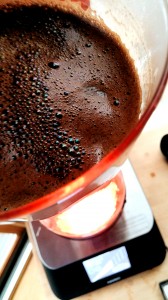 Should history ever agree to repeat itself in a different order, I’ve long felt the siphon would have been the ideal brewer to replace drip. After all, the siphon fixes the following drip issues:
Should history ever agree to repeat itself in a different order, I’ve long felt the siphon would have been the ideal brewer to replace drip. After all, the siphon fixes the following drip issues:
- Grounds to Water Ratios remain constant when making different size batches.
- Easy to maintain in-standard brewing temperature.
- Grind is less critical because it has no effect on contact time.
There may be other benefits too. But, in an effort to keep this review from taking my record for the all-time windiest, let’s now cut to our Hario version on the test bench. It’s a beauty all right. I promise not to let looks intoxicate me, but as with my marriage, I’m a sucker for looks. And this one’s a knockout. But, can it make coffee? And how! The Hario Syphon and its companion infrared heater are amazingly competent in that ability. This is a completely professional kit for any barista. Best of all, for the well-heeled devotee, it offers perhaps the ultimate home siphon setup. 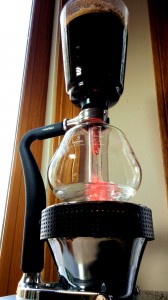 You get:
You get:
- A lower bowl on a sturdy metal stand. The glass is clearly a thick, robust, tempered type. The upper bowl’s stem (in my experience) is often prone to breakage, but with this unit so far, no such problem.
- Two filter types. You get the original cloth filter, that is most effective and (I think) the original method, offering the cleanest, clearest coffee. You also get a Hario-designed metal filter which effectively filters and apparently matches the flow rate of the cloth one, so they are interchangeable. More sediment but that’s what metal filters do. Much more convenient.
- Infrared heat. To me flames take too long, the liquid fuel is a hassle and flames vary in temperature due to air flow. To be honest, infrared still isn’t fast enough for me, but it looks beautiful and is wind resistant.
Say What You Think, Kev… I absolutely think this siphon is the best one I’ve yet used and I’ve used lots of them. It brews some of the best coffee I’ve ever had, which is saying a lot. But……… all siphon brewers I’ve yet tested have the following potential issues:
- Variable contact time. Try though I may, I find the idea of shutting off the heat and then expecting the coffee to dutifully drop back through that filter to the bottom again varies a bit. I’ve done pretty well overall. After some practice with this unit I was able to get a four minute contact time within fifteen seconds most of the time… but, not always. Compared to drip or other full immersion methods such as French press, the siphon varies more and I see no solution to this. I made one last batch before starting to write this review and I had a nearly six minute extraction. The coffee still tasted fine, but it is worth noting for those to whom it matters.
- The cloth filter is a hassle. Not this one in particular. All of them. If you’re an occasional user, it’s practically a no-go as storing the cloth filter requires cold water, a spot in the refrigerator to keep it cold, and frequent water replenishment. If you use the cloth filter often they are prone to absorbing built-up coffee tastes. The stainless filter, which I admit I used for most of my testing, allows fine sediment through. Paper, my personal filter material first choice is not an option. (Update: See below under tweaks for just such an option.)
- Heating, even with the fancy infrared heat source, is not fast. Compared to coffee brewers such as Bunn’s Phase Brew, Kitchen Aid’s KCM0802, OXO’s 12-cup Barista Brain and others that get the water to SCAA certified brew temps before contact begins, the room-to-ideal temperature on this siphon brewer using the Infrared heater is roughly ten minutes. Too long. I learned quickly to heat the water in a separate kettle first. Solves the problem and not that big a hassle, but still an extra step.
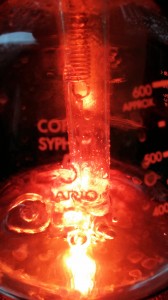 So, recommended or not? I will never knowingly write anything but the truth in this blog. While I acknowledge that this brewer still requires more active concentration from the end user, I also know it makes some of the best coffee I’ve yet tasted. No getting around it. For ultra-fresh coffee, very good quality coffee, roasted to its more flavorful degree, the Hario Syphon does a unique job. Carefully used, you can get a very thorough extraction, full of fruit and complexity. You truly feel you are tasting deep into the coffee. So, yes, highly recommended, with the caveat that you must become part of the task of brewing it. It is not yet truly automated in this product, and if used in a way that is automated, you are, in my opinion, giving up flavor in exchange. How Do I Use It? There are lots of ways to use a siphon or vacuum brewer. Here’s my personal method.
So, recommended or not? I will never knowingly write anything but the truth in this blog. While I acknowledge that this brewer still requires more active concentration from the end user, I also know it makes some of the best coffee I’ve yet tasted. No getting around it. For ultra-fresh coffee, very good quality coffee, roasted to its more flavorful degree, the Hario Syphon does a unique job. Carefully used, you can get a very thorough extraction, full of fruit and complexity. You truly feel you are tasting deep into the coffee. So, yes, highly recommended, with the caveat that you must become part of the task of brewing it. It is not yet truly automated in this product, and if used in a way that is automated, you are, in my opinion, giving up flavor in exchange. How Do I Use It? There are lots of ways to use a siphon or vacuum brewer. Here’s my personal method.
- Heat four cups of water in an electric kettle to 200°F.
- Weigh 38 grams fresh roasted beans and grind them a coarser than auto-drip but a notch or two finer than for Chemex drip (coarse).
- Once water is heated to 200°F, transfer it to the empty glass bottom half and place on infrared heater. Turn heater on to maximum or one notch less.
- Place empty upper mixing vessel with filter inserted into lower half so that they fit snugly together.
- After water has completely risen scoop or pour grounds into top half. Very gently stir near top to ensure all grounds are wet. Start timer.
- At one minute begin another few seconds of stirring. Do not stir downward, as I found if you do, there’s a risk that some amount of brewed coffee will work itself down into the bottom half. Reduce heat a few notches after stirring.
- At two minutes stir gently again. Lower heat a notch or two.
- At three minutes, stir one last time.
- At around three-twenty, turn off heat. After a few seconds, the coffee will begin its final descent into the lower bowl, which becomes a server upon completion.
- When the coffee has completely returned to the bottom, carefully unplug the upper bowl, remove it and place it in the top coffee, which when upside down, becomes a holder for the spent grounds.
- Serve.
Tweaks
You should know that I notice a significant difference between using a cloth and metal filter. The cloth does a more thorough job removing grounds, some might say ideal, although I’ve been around coffee long enough to know that ideal is a subjective term. Let’s just say it’s my favorite. At the recent CoffeeCon NY festival I noticed Georgio’s Coffee’s Georgio Testarossa using a siphon to brew his own delicious fresh-roasted coffee. I also noticed the brew’s viscosity matched my own using the cloth filter. I asked if he was using cloth. “No, paper”, he responded. “Paper”, I exclaimed. Then he disassembled his filter to reveal how he’d cut matching circles from a Bunn filter. 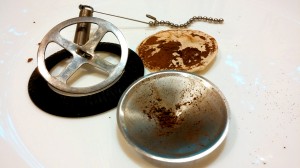 Some people use fine grind for vacuum. I used to, but lately I’ve found a coarser grind to work best. Siphons can use any grind as grind really does little to affect contact time. Of course surface area exposure affects the taste strength; that remains. Using the metal filter I find the coarse grind reduces particles in your cup. I use close to what I’d use for regular drip.
Some people use fine grind for vacuum. I used to, but lately I’ve found a coarser grind to work best. Siphons can use any grind as grind really does little to affect contact time. Of course surface area exposure affects the taste strength; that remains. Using the metal filter I find the coarse grind reduces particles in your cup. I use close to what I’d use for regular drip.
Conclusion
The Hario Syphon is a gorgeous brewer that can make state-of-the-art coffee. I had both the single-knob and digital control base units. I found each to work well. The digital control unit will appeal to anyone who enjoys its programmable features, although to be honest, I didn’t explore them. Different article. The filter options are enough to make me choose this vacuum unit. I never felt the glass was fragile and had no incidents nor near-incidents during my tests. About the only thing missing compared to drip pour-over such as a Hario V60 is the ease of controlling brewing temperature. Vacuum/siphon is high-temperature brewing, inherent in the process. But the results are impressive. Any time during my time with this unit that anyone came to visit they immediately noticed the unit. Whenever I offered to make coffee and asked if they had a preference, the unanimous response was to point directly at the Syphon and say, “That one!”
Unhesitatingly, highly recommended.
by Coffee Kevin | Apr 13, 2016 |
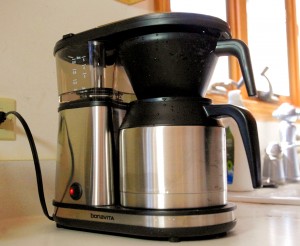 Bonavita practically owns what might have once been called “The Chevy” market. This meant, again at one time, a good quality, well designed product that was easy to use and maintain. It had no stunning features, but was priced for everyman. I suppose in automobiles Chevy has been replaced by Toyota, or recently, Hyundai.
Bonavita practically owns what might have once been called “The Chevy” market. This meant, again at one time, a good quality, well designed product that was easy to use and maintain. It had no stunning features, but was priced for everyman. I suppose in automobiles Chevy has been replaced by Toyota, or recently, Hyundai.
Bonavita hit the marketplace with a Melitta-designed 8 cup coffee maker. It was known as a lower-priced Technivorm but that’s really not the truth. It was a lower-priced Technivorm that increased the water spray width to better match the grounds basket width. Generation 2 Bonavita brewers (no longer designed by Melitta) went further by adding pre-infusion features and switched to flat bottom filters, all in the pursuit of better cup quality. Bonavita gets good marks in the consumer press, including this blog.
Recently, Bonavita brought out this model, which is for the growing medium batch market. Households with two coffee drinkers don’t need eight or ten cups each time they brew. Consumers have realized that fresh is best, and in my home, I brew a couple of cups for each of us each morning. If we are home and wish a repeat dose after lunch or later, we simply repeat the process. It reduces waste too. I pay roughly $20 per pound for specialty beans and, believe me, I cringe whenever I see leftover coffee go down the drain.
The Bonavita 5-cup returns to their Melitta roots with the use of a V-shaped cone filter. They used a number 4 filter, which Bonavita, ever the practical company determined was the easiest to find, plus it gives the coffee plenty of room to expand, which truly fresh coffee does in the first few minutes of brewing. I assume a V-shape was chosen to increase saturation and slow brewing slightly. With an 8-cup brewer, there’s a concern about the brewing happening quickly enough, so that the grounds are not over-extracted. With the smaller batch of a 5-cup, the opposite is true. All drip machines are a carefully thought-out process where grind, volume and time are matched to create the ideal extraction. So, whenever I test a new different-size batch coffee maker, even from a manufacturer of another machine, I spend a fair amount of time playing with the variables I as consumer have over the process.
For instance, I initially tried a grind similar to what the Bonavita 8-cup uses. I found this was the most important thing to tweak. This is not specific to this brewer, but the shorter the contact time, the precise grind needs to be, in my experience. I played with typical cone Melitta-style grinds and finally ended up using a somewhat coarser grind. Not as coarse as Chemex, but definitely coarser than I’d use for most cone filter machines. I also settled on 42 grams of coffee to deliver a cup of coffee I could really enjoy.
The Bonavita 5-cup also has a pre-infusion stage which is easy to implement. You simply hold the on button in place for a few seconds. Once it blinks, simply release it and press it on again. Every time you start it the pre-infusion stage will work until you physically unplug it. This stage is important to anyone who uses coffee two weeks from roast, which is how I do it and I assume you do too. It’s technically known as “fresh coffee”. Of course I’m also assuming we’re all fresh grinding it seconds before we brew.
Consistent with the whole 1960 Chevy concept Bonavita doesn’t waste time with metal filters, on-board water filters, alarm clocks or other non-essential frills.
How does it test? I measured the temperature right at the hot water exit holes. It is slightly lower in temperature than I expected. It peaks at near 200°F, 199°F to be exact. The first minute was spent climbing “to altitude”. While not seeming ideal, it probably matches many slow brew methods in practice. Most people who use a Chemex may not measure their brewer’s temperature, but sub-200°F temperatures are quite common in practice. It doesn’t really bother me, but it did bother the SCAA, who held to their exact temperature specs their certification program demands.
A non-certification test, but one I consider critical and a hallmark of every other Bonavita brewer I’ve yet tested is the water dispersion, which is truly excellent with this machine. Dispersion is geek-speak to describe what happens when a skilled barista constantly surveys the grounds in your Chemex and makes sure the water covers the grounds, ensuring there are no dry spots and that all the grounds receive equal saturation. In practical terms this means you get strong flavor that is less bitter, than it is if you concentrate the water too much on one particular spot.
The contact time between the hot water and the grounds is slightly under 5 minutes. This is at the short end of the SCAA brewing specification of 4-6 minutes for drip. Again, I could get all sniffly about it, but I found that it was not a problem. If I were to guess I’d say the aforementioned water saturation is so efficient it accomplishes the right amount of extraction in less time.
A note about temperatures: I think the range of 196° to 205°F called for in the SCAA standards (themselves adaptation of the original Pan American Coffee guidelines developed many years ago) are reasonable. I agree we need to start somewhere, but there’s also a big difference between a brewer that misses the mark by a degree or two, while still meeting other criteria versus ones that don’t seem to even try, frankly, most of the ones out there made by the largest small appliance makers.
Taste tests:
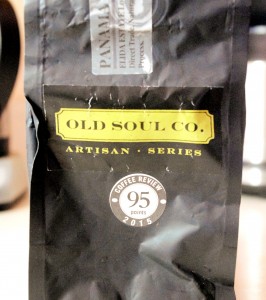
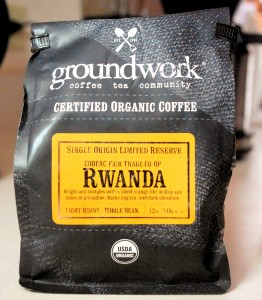


Test 1 – I made a batch using Groundwork Coffee’s Organic Rwanda, they’d been kind enough to share with me at CoffeeCon LA. I already enjoyed it in my Bonavita BV1900S, but I made it improperly in this first outing. Although the coffee had the same notes, everything was out of balance, and auspicious beginning. I realized I’d used 44 grams (still not sure why) and a medium coarse grind as I would in an 8-cup flat bottom brewer. I’m only reporting it because I can’t say enough about how important it is to use the right recipe.
Test 2 – Next, I was able to snare Old Soul Coffee’s Panama Elida Estate Lot #13, which was rated 95 by Ken Davids in The Coffee Review. What a fruit bomb! Fortunately I backed off the recipe to just about 42 grams. What a difference! I strongly recommend this coffee to anyone who’s convinced that the recent Panama Geisha invasion is only attributed to the Geisha bean. While I’m a fan of Geishas, this coffee proves a Panama coffee can be stellar and not be Geisha. This one isn’t a Geisha, but it’s delicious.
Test 3 – Kean Coffee’s Congo Lake Kivu is a rarity for me. I’ve never before had a Congo coffee. I guess I’ve been missing a lot. This coffee, selected and roasted by Martin Diedrich, is not only a wonderful bean, but Martin is not afraid to roast it just a shade darker. It suits this brewer perfectly. I had trouble trying anything else after I’d tasted this.
Test 4 – Finally, I received a Sumatra Mandheling from Mr. Espresso in Oakland. John DiRiuocco uses a wood fired roaster. I know nothing professionally about roasting, but I do know how heat is applied makes a difference. That and a honey roasted Sumatra made for an interesting sample. I’d brewed tests of this coffee (and compared them to an Oren’s Daily Roast Mandheling I also had in stock) and discovered I preferred it brewed near the 195°F mark, so it was a good fit for this brewer. I used 42 grams medium finely (#12 grind on my Baratza Encore grinder). I felt I’d finally arrived at the perfect intersection of coffee bean, recipe and grind setting, the holy trinity of good automatic drip brewing.
Previous review note: I make it a policy never to read other reviews while mine is in progress. I had seen this one however and I noticed CNET’s reviewer (Brian Bennett) noted a bitter taste. I’m not sure what the difference was, but I was unable to produce a bitter coffee during any testing of this machine, which was over a one month test period. Two test results I tested and reported that could cause bitterness, temperature and contact time, are both at the low end in this machine, so that are unlikely (ne impossible) to produce this result. Other factors could be his choice of beans, which he did not identify. I only test using lighter (Third Wave style) high end specialty beans, in this case two of our samples were brewed using beans rated in the mid 90s in the Coffee Review. No bitterness whatsoever. I’m unaware of other factors that would result in bitterness. Maybe he needs to check his water supply. If Mr Bennett wants to contact me, reveals his bean choices and discuss other possible causes, I’d be happy to share them. I’m befuddled by his claim. In any case I didn’t find cause to be concerned and I suggest it’s unlikely under your conditions.
Conclusion: I’m getting spoiled lately. Between my manual drip methods, and some ultra-sophisticated automatic drip brewers which feature multiple brewing temperatures, which is one reason I was able to simply match up a coffee to this one’s brewing temperature range. However, those machines are larger and costlier, both in base price and coffee to keep it going (think gas mileage). The Bonavita 5-cup makes four/five delicious cups of java. Consider that the smaller the batch size and brewing time, the more precise you must be in measuring your coffee grounds and grind. That said, I could easily live with this brewer. If you want a trouble-free, easy to use, no frills but high quality brewer to make fresh specialty coffee for you and a friend, the Bonavita BV1500S five cup is a good choice.
by Coffee Kevin | Apr 6, 2016 |
The Bonavita coffee makers are the current coffee maker for everyman. They are easy to use, forgiving of those who do not self-identify as geeks; those of us who just want to scoop our grounds in, fill with water and press go. Bonavita coffee makers were originally Melitta units, the first generation designed in Germany by Melitta, who license their brand name to Hamilton Beach in the US.
Bonavita coffee makers were originally Melitta units, the first generation designed in Germany by Melitta, who license their brand name to Hamilton Beach in the US.
Espresso Supply distributes them and, when Espresso Supply took over their distribution, I had my doubts. Their background is, as the name implies, espresso. They have a separate line of manual brewers, including a widely used variable temperature kettle. They had no experience with electrics. Yet, the public and cafes seem delighted with this company’s approach.
What Espresso Supply is, is dedicated to brewing coffee. This means they really seem to understand both the consumer (you and me) and the process, and it shows in just about everything they do. I met Chris Legler, their Financial Strategist, a few years ago now. Now, if you know me, you’ll know this is a role I would usually dismiss as one of the suits, about as useful to know as Human Resources. As I got to know Chris, I developed a lot of respect for his devotion to coffee and brewing. I came to learn he worked for Sony, a company I long ago admired for their understanding of their audience and both sound and visual products, at least in their heyday.
I see Chris the same way, and I invite you to eavesdrop on a more or less typical conversation between us about brewing. Note: He has no problem discussing any brand of coffee product. He realizes we’re discussing something bigger and has that sense of history not often found in corporate cultures. And, he actually seems to use his (and everyone’s) coffee brewing products!
This podcast was recorded at the NCA Conference in San Diego in March, 2016. Thanks to Joe DeRupo, NCA’s Director of External Relations and Communication, who provided the recording space.
Podcast: Play in new window | Download
Subscribe: Android | Email |
 One of the reasons I so enjoy the Specialty Coffee Association’s Expo is running into products that are in the pipeline, but not quite ready. I realize how this happens. The inventors are tweaking them up until showtime and then the lights come up. Do we or do we not exhibit it? I mean it’s not quite ready? As we used to say in my previous life in television, “We never finish anything. We just abandon it.”
One of the reasons I so enjoy the Specialty Coffee Association’s Expo is running into products that are in the pipeline, but not quite ready. I realize how this happens. The inventors are tweaking them up until showtime and then the lights come up. Do we or do we not exhibit it? I mean it’s not quite ready? As we used to say in my previous life in television, “We never finish anything. We just abandon it.” It’s worth noting it’s my opinion that the use of such a tool will become more and more useful as it covers more variables. If course as it stands today, it will help maintain brewing consistency. But the real power will come when it monitors the grind. Those of us who attempt to vary batch sizes in a drip brewer know that slight grind adjustments can enable practically identical flavor profiles when changing batch sizes, and this is really difficult. While the demo didn’t demonstrate the app’s capability to change batch size parameters, and it’s unlikely that v1 addresses grind at all. Long term this is the dream I have for all of these products.
It’s worth noting it’s my opinion that the use of such a tool will become more and more useful as it covers more variables. If course as it stands today, it will help maintain brewing consistency. But the real power will come when it monitors the grind. Those of us who attempt to vary batch sizes in a drip brewer know that slight grind adjustments can enable practically identical flavor profiles when changing batch sizes, and this is really difficult. While the demo didn’t demonstrate the app’s capability to change batch size parameters, and it’s unlikely that v1 addresses grind at all. Long term this is the dream I have for all of these products.












